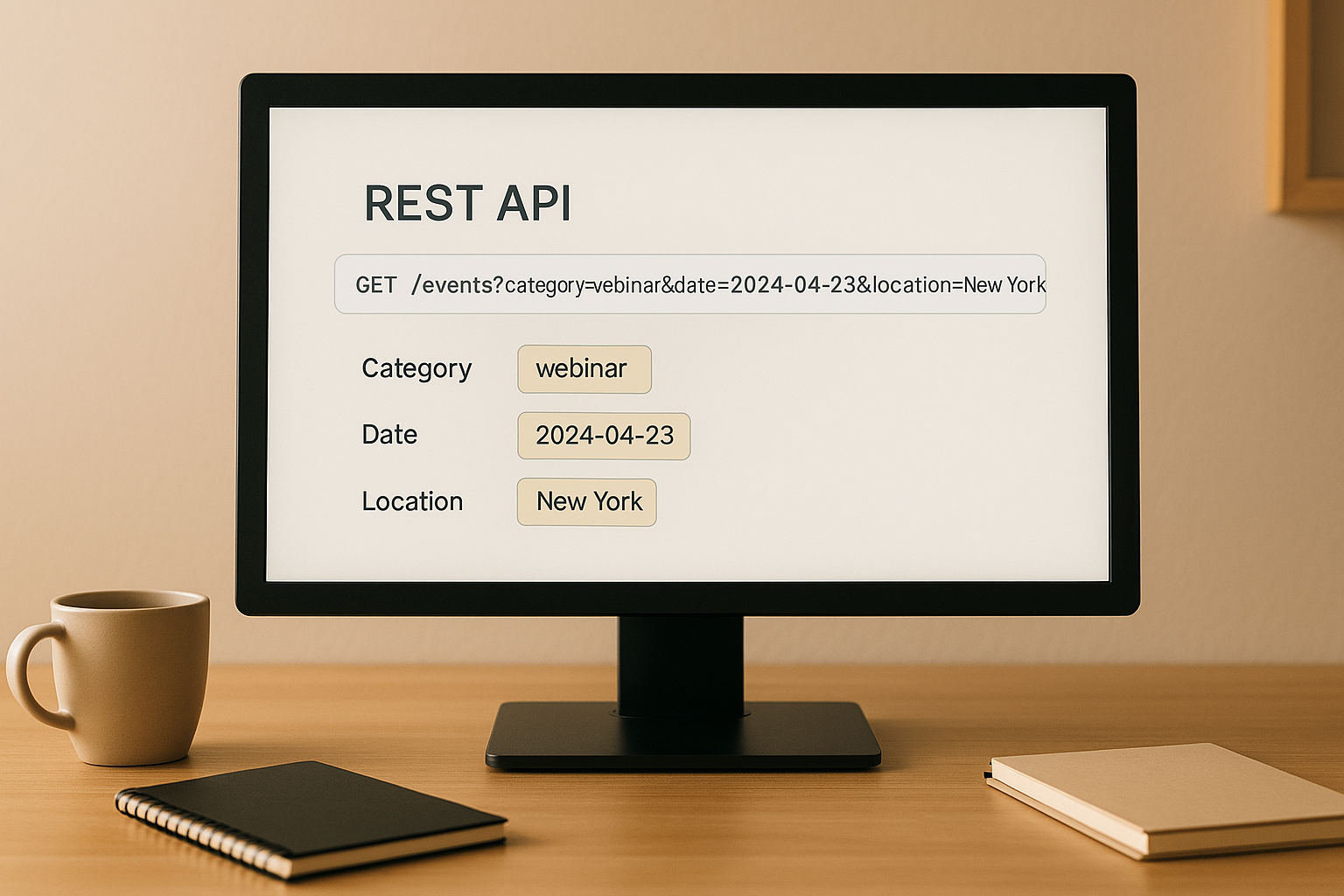Filtering events in REST APIs lets you request only the data you need, improving efficiency, reducing server load, and speeding up responses. The process involves using query parameters and operators to define conditions for retrieving specific records, like filtering by date, category, or status. Here's the core idea:
Query Parameters: Add key-value pairs to the URL (e.g., ?date=2022-03-01) to filter events by specific fields.
Operators: Use comparison operators like eq (equals), lt (less than), and gt (greater than) for advanced filtering (e.g., ?price_lt=50).
Combining Filters: Combine multiple conditions with logical AND/OR to refine results (e.g., ?category=music&status=active).
Database Optimization: Apply filters at the query level to retrieve only relevant data, improving performance.
Filtering ensures APIs deliver precise results, saving bandwidth and enhancing usability. Proper implementation requires defining filterable fields, validating inputs, and optimizing database queries while documenting the process clearly for developers.
Adding Filtering, Sorting And Pagination To a REST API | .NET 7
Common Methods for Filtering Events in REST APIs
Filtering events in REST APIs is a practical way to ensure clients receive only the data they need. Most APIs achieve this by using URL query parameters combined with comparison operators. This approach keeps API calls straightforward and easy to understand while offering flexibility.
Using Query Parameters for Filtering
Query parameters are the simplest way to filter events in REST APIs. By adding key-value pairs to the URL (after the ?), clients can request specific data without dealing with complex syntax.
For example, if you're filtering events, query parameters might include date (to specify a particular day), category (to filter by event type), or status (to indicate event states). Here’s how this looks in practice:
Date filtering: https://example.com/api/events?date=2022-03-01
Category filtering: https://example.com/api/events?category=music
Keyword search: https://example.com/api/events?q=conference
For more tailored results, you can combine parameters within a single URL. For instance:https://example.com/api/events?category=music&date=2022-03-01.
To avoid confusion, it’s a good idea to use clear, descriptive parameter names that match the API's data model. This also makes the API documentation easier to follow.
Operator Support for Advanced Filtering
While basic equality filters (like status=active) work for simple cases, comparison operators allow for more refined searches. Common operators include:
eq (equals)
ne (not equals)
gt (greater than)
gte (greater than or equal to)
lt (less than)
lte (less than or equal to)
For example, to filter events starting after 9:00 AM, you could use:/api/v1/events?startTime=gt:09:00.
Another common syntax uses underscores, such as price_lt=20 (for prices less than 20) or price_gt=100 (for prices greater than 100).
Some APIs also support additional operators like co (contains), sw (starts with), ew (ends with), and pr (present). These operators enable even more detailed queries. For instance:https:////admin/v1/AuthPolicies?filter=policyId co 3 and policyName co a and policyName eq AdminLoginPolicy.
Combining Filters with Logical AND/OR
In many cases, you’ll need to combine multiple conditions. By default, most APIs interpret multiple parameters as a logical AND. For example:GET /events?status=active&type=webinar
This query returns events that are both active and of the webinar type.
For a logical OR, you can use comma-separated values:GET /events?category=workshop,conference
This retrieves events that fall into either the workshop or conference category.
By combining these filters, developers can create complex queries. For instance, you could filter events within a specific date range while also narrowing results by category or status. To ensure consistency across endpoints, some developers adopt standards like the Open Data Protocol (OData) Filter System Query Option specification.
For those using DreamFactory, these filtering techniques are straightforward to implement. The platform’s powerful API generation and built-in filtering tools simplify the process, making it easier to build robust REST APIs.
Step-by-Step Guide to Implementing Event Filtering
Event filtering can be broken down into three main steps: defining filterable fields, validating inputs, and optimizing database queries. Let’s explore each step with practical examples to help you implement filtering effectively.
Defining Filterable Fields and Operators
Start by identifying which database fields should be filterable. Instead of making every field available, focus on those that align with common user needs. Typical filterable fields include date, category, status, location, and price, as these often reflect frequent search behaviors. For instance, users might search for events happening within a specific date range or filter by category (like music events or conferences).
Once you’ve selected the fields, assign appropriate operators to each. For example:
Strings: Use operators like eq (equals), co (contains), sw (starts with), and ew (ends with).
Numbers: Use operators such as gt (greater than), lt (less than), gte (greater than or equal to), and lte (less than or equal to).
Dates: Incorporate range operators to allow filtering by specific timeframes.
Here’s an example of how this works:
To find events priced above $50: GET /events?price_gt=50
To search for events in the "books" category: GET /events?category=books
Using consistent operator syntax across your API ensures clarity and reduces user confusion. Begin with basic filtering options and expand to more advanced capabilities over time.
Parsing and Validating Filter Parameters
Input validation is critical for maintaining security and data integrity. Each filter parameter should be checked for length, range, format, and type to prevent malicious input.
Strict Data Types: Define accepted values for fields like status (e.g., active, inactive, pending) or category (e.g., music, conference, workshop). For numeric fields, set reasonable minimum and maximum values. Date fields should follow a standard format, such as MM/DD/YYYY, and be validated against realistic ranges.
String Validation: Use regular expressions to enforce specific patterns. For example, if filtering by event codes, match the expected format to block invalid inputs and guard against injection attacks.
Validation Libraries: Leverage existing libraries or frameworks to simplify the process. These tools can handle input sanitation and reduce the need for custom logic.
Additionally, implement safeguards like request size limits to prevent abuse and log validation failures to help identify potential security threats. A whitelist approach - accepting only predefined, safe parameters - adds another layer of protection.
Once the inputs are validated, you can confidently pass the filters to your database queries.
Applying Filters at the Database Query Level
Validated filters should be applied directly to database queries to maximize efficiency. By filtering at the query level, you can reduce the amount of data retrieved, lower server load, and improve overall performance.
Index Key Columns: Index frequently filtered fields (like date, category, and status) to speed up query execution.
Caching: Use caching mechanisms for filters that are frequently requested to further enhance performance.
Pagination: Even with filters, results can be extensive. Implement pagination to limit the number of records returned, improving response times and user experience.
When building queries:
For SQL databases, dynamically construct WHERE clauses based on filter parameters.
For NoSQL databases, use query methods specific to the database type.
Use efficient data structures, such as hash tables or sets, to handle complex filtering scenarios.
If manual query optimization feels overwhelming, tools like DreamFactory can simplify the process. DreamFactory automatically converts REST API filters into optimized database queries, ensuring high performance without requiring you to write complex query logic manually.
Best Practices for Customization and Documentation
Implementing a filtering system is just the beginning. To ensure it's maintainable and secure, you need to adopt practices that prioritize clarity, consistency, and robust access control.
Consistent Naming Conventions for Filters
Using clear and consistent naming conventions can save developers time and eliminate unnecessary confusion. For example, names like price_lt or category_music make it easy to understand what the filter does without extra guesswork. When filter parameters mirror the names of underlying data fields, developers can construct queries intuitively without constantly checking the documentation.
Here are a few tips for naming filters effectively:
Stick to lowercase letters and hyphens (e.g., event-category) for uniformity.
Consider a unified naming scheme to differentiate filters from other query parameters like sorting or pagination. For instance, prefix filters with filter_ (e.g., filter_category, filter_date) or group them into a structured array for clarity.
Use query parameters appended directly to the URL for simplicity. For example, applying multiple filters might look like this:GET /events?category=music&price_lt=100
This query would return music events priced under $100, with filters functioning as a logical AND operation.
These practices make it easier for developers to understand and apply filters effectively.
Documenting Filter Capabilities
Once your filters have clear names, thorough documentation is the next step to ensure smooth adoption by developers. High-quality API documentation combines accurate references, practical examples, and interactive tools to guide users.
Here’s what great documentation should include:
API Reference: List every available filter, its supported operators, and expected data types. Include example requests and responses to demonstrate how filters work in practice.
Step-by-Step Guides: Go beyond the basics. Explain not just the technical details but also the "why" and "how" of filtering. For example, describe real-world scenarios where these filters would be useful.
Interactive Tools: Provide a "Getting Started" section with simple authentication options (like personal tokens) to let developers test filters quickly. Offering complete example applications or integration code on platforms like GitHub can also make a big difference.
By combining these elements, your documentation can serve as both a learning tool for new users and a reference for experienced developers.
Role-Based Access Control in Filtering
Security is just as important as usability when it comes to filters. Role-Based Access Control (RBAC) ensures users only see data they’re authorized to access, reducing the risk of exposing sensitive information.
Here’s how to apply RBAC effectively in your filtering system:
Define Roles: Assign roles based on actual user responsibilities. For example, a "manager" role might have broader filtering access than a "regular user."
Granular Permissions: Grant permissions specific to each role, ensuring users can only access data relevant to their responsibilities.
Centralized Access Management: Use a centralized system to manage filtering permissions consistently across your API. This helps prevent gaps in security. For instance, tools like Azure Key Vault offer unified access control models that span both control and data operations.
At the query level, enforce role-based restrictions to ensure users can only filter data they are allowed to view. Platforms like DreamFactory simplify this process by automating RBAC, API key management, and OAuth integration.
Examples of Event Filtering in Practice
Let's dive into some practical ways event filtering can streamline data management and boost efficiency. These examples build on the filtering methods discussed earlier.
Basic Filtering Examples
Single-condition filters are straightforward and retrieve events based on one specific criterion. For instance:
To fetch all active events:
GET /events?state=active-This query will return only events marked as active.
To find events scheduled for a particular date:
GET /events?date=03/01/2022
-This retrieves events happening on March 1, 2022.
To organize events by type, such as conferences or workshops:
GET /events?category=conference
GET /events?category=workshopCombining Filters for Specific Results
For more precise results, you can combine multiple filters in a single query. For example:
To find music events priced under $100:
GET /events?category=music&price_lt=100Advanced APIs allow even more complex queries using logical operations. For example, you can search for active events that are either music or conferences, while also filtering by price:
GET /events?category=music,conference&price_lt=100&status=activeThis approach lets you mix and match criteria to pinpoint exactly what you're looking for.
Filtering by Related Entities
Filtering can also extend to related entities, making it possible to refine searches based on relationships. For instance:
To filter events tied to a specific user and project:
GET /events?userId=123&projectId=456Some APIs even allow filtering based on nested properties of related entities. For example, to find events where attendees are engineering managers:
GET /events?attendee.department=engineering&attendee.role=managerTools like DreamFactory make this process even easier. By automating API generation across different database types, it simplifies filtering based on relationships without requiring custom queries for each connected entity. This makes it a powerful option for handling complex data structures efficiently.
Conclusion
Event filtering plays a key role in making REST APIs more efficient. It helps cut down on bandwidth use, speeds up response times, and improves the overall experience for developers using your API. When done right, filtering creates a seamless and productive environment for developers.
To maximize these benefits, focus on solid design and clear documentation. Well-implemented filtering, paired with easy-to-follow documentation, not only enhances API performance but also improves usability and long-term maintenance. Your documentation should include interactive code samples, detailed operator explanations, and real-world examples that show how different filters can work together effectively.
Security is another critical aspect, especially when dealing with sensitive data. Ensuring proper role-based access controls and validating filter parameters are essential steps to keep your API secure.
For those looking to simplify the process, tools like DreamFactory offer an automated approach. These platforms generate secure REST APIs with built-in filtering across multiple databases, saving time on manual coding while maintaining strong security and documentation standards.
FAQs
Query parameters play a key role in making REST APIs more efficient by letting clients request just the data they actually need. This means less unnecessary information is transferred, leading to faster response times and reduced bandwidth usage.
They also allow for precise and dynamic data retrieval, which helps lighten the server's workload. This makes API interactions smoother and more efficient, especially when tailoring responses to fit the specific needs of different clients.
To keep your REST APIs secure and ensure data integrity when validating filter parameters, consider these key practices:
Use allowlists: Only permit specific, pre-approved values while blocking anything unexpected. This approach minimizes the risk of harmful inputs slipping through.
Enforce strict data type validation: Check that inputs match the required types - like numbers, booleans, or dates - and apply constraints such as fixed ranges or maximum string lengths to prevent injection attacks.
Perform server-side validation and sanitization: Always validate and clean user inputs on the server side to ensure data integrity and guard against tampering.
These steps help protect your API from security vulnerabilities while ensuring consistent and reliable data handling.
Using logical operators like AND and OR helps you build more refined and adaptable API filters, making it easier to retrieve exactly the data you need. For example, AND ensures all conditions are met, narrowing the results, while OR expands the search by matching any of the specified criteria.
This method lets developers create precise queries that align closely with their requirements, ensuring API responses are both efficient and relevant. By blending these operators, you can tackle even the most complex filtering tasks, streamlining workflows and improving the accuracy of the data you retrieve.
Kevin McGahey is an accomplished solutions engineer and product lead with expertise in API generation, microservices, and legacy system modernization, as demonstrated by his successful track record of facilitating the modernization of legacy databases for numerous public sector organizations.
























 Blog
Blog


